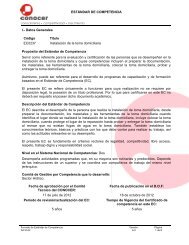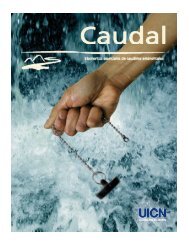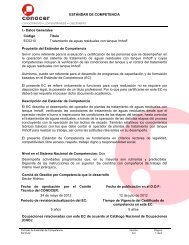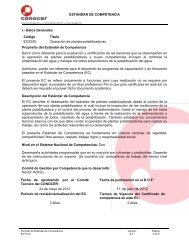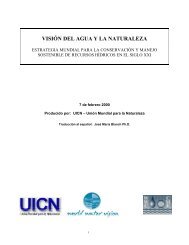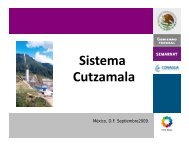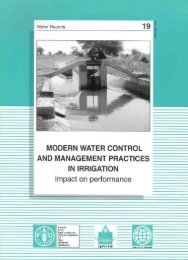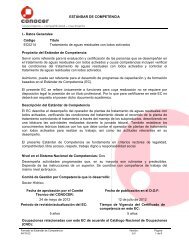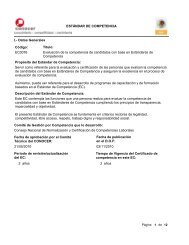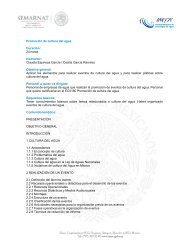Agricultural drainage water management in arid and semi ... - FAO.org
Agricultural drainage water management in arid and semi ... - FAO.org
Agricultural drainage water management in arid and semi ... - FAO.org
Create successful ePaper yourself
Turn your PDF publications into a flip-book with our unique Google optimized e-Paper software.
30Framework for select<strong>in</strong>g, evaluat<strong>in</strong>g <strong>and</strong> assess<strong>in</strong>g the impact of <strong>dra<strong>in</strong>age</strong> <strong>water</strong> <strong>management</strong>Comb<strong>in</strong>ed measuresA s<strong>in</strong>gle economic or policy <strong>in</strong>strument will probably not resolve <strong>water</strong> pollution problemsorig<strong>in</strong>at<strong>in</strong>g from irrigated agriculture. Comb<strong>in</strong>ations of policies can help to enforce their effect.Especially <strong>in</strong> situations where farmers are <strong>in</strong>equitably charged, a comb<strong>in</strong>ation of measures mighthelp to charge farmers more equitably. For example, emissions from an irrigation district couldbe measured <strong>and</strong> f<strong>in</strong>es applied where limits are surpassed. These f<strong>in</strong>es could then be distributedamongst the farmers, apply<strong>in</strong>g a rank<strong>in</strong>g based on how farmers have used their <strong>in</strong>puts or whatmeasures they implement. The most <strong>in</strong>efficient users should then pay comparatively more thanthe most efficient ones.SELECTION AND EVALUATION OF DRAINAGE WATER MANAGEMENT OPTIONSNormally, more than one <strong>dra<strong>in</strong>age</strong> <strong>water</strong> <strong>management</strong> option will need to be considered <strong>and</strong>implemented to atta<strong>in</strong> the desired objectives. In this case, <strong>in</strong>teractions <strong>and</strong> trade-offs occur.Because of the complexity of the processes <strong>and</strong> <strong>in</strong>teractions, computer models are best suitedto select<strong>in</strong>g an optimal comb<strong>in</strong>ation of <strong>dra<strong>in</strong>age</strong> measures. As was expla<strong>in</strong>ed <strong>in</strong> Chapter 2, theselection of a set of <strong>dra<strong>in</strong>age</strong> <strong>water</strong> <strong>management</strong> measures requires more considerations thansolely technical feasibility. Figure 11 shows a flowchart for select<strong>in</strong>g a set of <strong>dra<strong>in</strong>age</strong> <strong>water</strong><strong>management</strong> measures (AHCC, 2000).Step 1 is to gather technical, environmental, social, economic <strong>and</strong> <strong>in</strong>stitutional <strong>in</strong>formationabout the site <strong>and</strong> the available <strong>dra<strong>in</strong>age</strong> <strong>water</strong> <strong>management</strong> options. Step 2 is to evaluate thedesirability of the options from a technical <strong>and</strong> environmental perspective. Typically, this stepFIGURE 11Flowchart of process for select<strong>in</strong>g an optimal set of <strong>dra<strong>in</strong>age</strong> <strong>water</strong> <strong>management</strong> optionsStartStartStep 1: Gather technical,Step 1: Gather technical,environmental, social,environmental, social,economic <strong>and</strong> <strong>in</strong>stitutionaleconomic, <strong>and</strong> <strong>in</strong>stitutional<strong>in</strong>formation, <strong>and</strong> determ<strong>in</strong>e<strong>in</strong>formation <strong>and</strong> thethe <strong>dra<strong>in</strong>age</strong> <strong>water</strong><strong>dra<strong>in</strong>age</strong> <strong>water</strong><strong>management</strong> options.<strong>management</strong> options.Step 2: EvaluateStep 2: Evaluatedesirability of the optionsdesirability of the optionsfor the site from afor the site from atechnical <strong>and</strong>technical <strong>and</strong>environmental perspective.environmental perspective.Step 3: Rank the optionsStep 3: Rank the optionsfor the site based on theirfor the site based on theirtechnical <strong>and</strong>technical <strong>and</strong>environmental suitability.environmental suitability.Step 4: Evaluate theStep 4: Evaluate theeconomic feasibility <strong>and</strong>economic feasibility <strong>and</strong>efficiency of the site’sefficiency of the site’soptions <strong>and</strong> re-rank optionsoptions <strong>and</strong> re-rank optionsif required.if required.Step 5: Evaluate the social,Step 5: Evaluate the social,<strong>org</strong>anization <strong>and</strong><strong>org</strong>anisation <strong>and</strong><strong>in</strong>stitutional issues, if<strong>in</strong>stitutional issues, ifnecessary, re-rank aga<strong>in</strong>.necessary, re-rank oncemore.Step 6: Integrate theStep 6: Integrate thetechnical, environmental,technical, environmental,social, economic, <strong>and</strong>social, economic, <strong>and</strong><strong>in</strong>stitutional <strong>in</strong>formation,<strong>in</strong>stitutional <strong>in</strong>formation,culm<strong>in</strong>at<strong>in</strong>g <strong>in</strong> aculm<strong>in</strong>at<strong>in</strong>g <strong>in</strong> arecommended plan.recommended plan.Source: based on AHCC, 2000.Step 7: Write a reportStep 7: Write a reportdescrib<strong>in</strong>g recommendeddescrib<strong>in</strong>g recommendedoptions <strong>and</strong> the order <strong>in</strong>options <strong>and</strong> the order <strong>in</strong>which they should bewhich they should beimplemented.implemented.EndEnd



